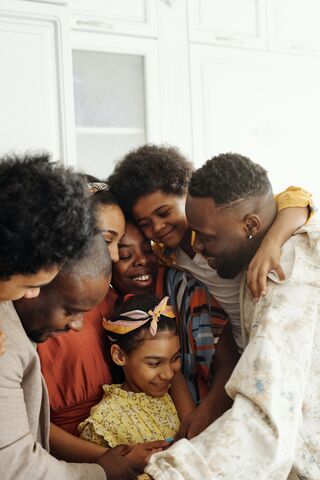Marriage
3 Myths About Blended Families
Let's clear up some common myths about the American blended family.
Posted August 16, 2022 Reviewed by Abigail Fagan
Key points
- Myth 1: Blended families struggle more than non-blended families.
- Myth 2: Blended families aren't as close as traditional families.
- Myth 3: Stepparents should treat their stepchildren exactly like their own biological kids.

There's no question that families come in all shapes and sizes—and about 40 percent of families in the United States have even decided to join forces.
According to 2015 U.S. Census Bureau data shared by the Pew Research Center, about one in six kids (16 percent) live in blended households. And the National Center for Health Statistics says that nearly two in three women (63 percent) create blended families when they choose to remarry.
Are you and your partner raising children from one or both of your previous relationships? Do you have concerns about starting a blended family with your partner, or are you confused about the stigma or misinformation surrounding stepchildren or half-children? Let's create some clarity about these unique family units and bust some myths so you can focus on what matters most: helping your marriage and family thrive.
What Is a Blended Family?
A blended family is comprised of spouses or partners who have children from prior relationships. Within a blended family unit, there is at least one stepparent, step-sibling, and/or half-sibling—and often more than one!
Members of blended families can live in one or multiple households. Many kids alternate residing at each of their biological parents' homes (e.g., "Mom's house" vs "Dad's house"), where they often live with other siblings or stepparents. The schedule that dictates when a child switches between residences depends on a wide range of factors including custody arrangements, geographical location, and family preferences.
Blended families come from all ethnic, racial, and socioeconomic backgrounds. Children who identify as Hispanic, Black, or white are equally likely to come from blended families, whereas children who identify as Asian are about half as likely as their Hispanic, Black, or white peers to come from blended families.
3 Common Misconceptions About Blended Families
If you have or are about to join a blended family, then congratulations on creating what can be a rewarding and sometimes-tricky life experience! Here are some common myths I've heard about this common genre of the American family unit that I'd like to clear up:
Blended families struggle more than non-blended families.
There's no question that people in blended families face unique challenges that "traditional" or non-blended families don't: the logistics of multiple homes and schedules, different family values and expectations, the unique stressors of parental divorce or separation. There's even some research suggesting that children of blended families have an increased risk of mental health and academic problems compared to children from non-blended homes.
But plenty of other research has found no significant difference in life outcomes for kids based on their family type—provided that the kids feel optimally supported and share healthy bonds with their caregivers.
The takeaway I offer to my remarried clients is this: yes, your blended family may present you with unique challenges, but how you choose to negotiate those challenges and who you decide to be as co-parents has much more of an influence over your kids' well-being than the family structure itself.
Blended families aren't as close as traditional families.
It's my professional observation that blended families can and do achieve the kind of close, healthy, and fulfilling bonds that many traditional or "intact" families enjoy (and I use the term "intact" very lightly, since it's not necessarily true that families untouched by divorce or separation are more cohesive than the alternative). Might it take more of a concentrated effort on your and your spouse's part to build those bonds? Maybe...but I'm not about to say that's a bad thing!
Ways to help your blended family truly thrive include:
- Creating new family traditions, such as family game nights or holiday traditions (while still honoring and holding space for any other traditions)
- Establishing a household culture of open and honest communication
- Seeking professional support in the form of individual therapy, couples' therapy, and/or blended family therapy, which can help you and your loved ones gain the tools, knowledge, and coping skills necessary to adapt and grow together (and help you and your partner maintain a healthy marriage, which is key for the overall success of your family)
Stepparents should treat their stepchildren exactly like their own biological kids.
My answer to this one: yes and no.
Yes, stepparents should treat their stepchildren as their own, in the sense that all kids in a blended family deserve equal amounts of attention, privacy, and love. If you choose to combine families with your partner, then treating all members with equal respect and dignity is absolutely non-negotiable.
But as a stepparent, you also need to honor the fact that kids likely share unique bonds with their biological parents, and—at least in the beginning—bio parents may need to take the leading role in things like disciplining the kids. This can help children adjust to new caregivers in their lives while minimizing feelings of confusion, resentment, or fear.
What this means for you: Routinely discuss your ideas with your spouse (privately, of course) about shared family values, household rules, and boundaries, but be willing to defer to your partner when it comes to deciding on and implementing disciplinary actions towards their biological children.
Are You From a Blended Family?
Like all family units, blended families come with a broad and highly personal mix of joys and challenges. Your blended family is a unique mix of interesting, different and special. Learn how to embrace the journey.




